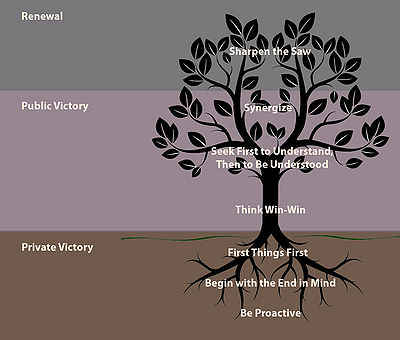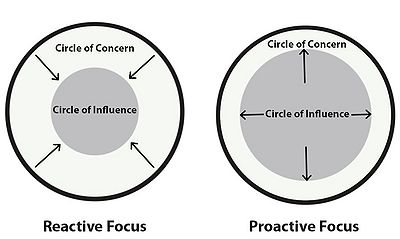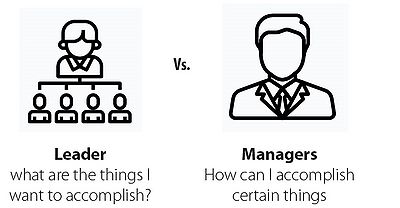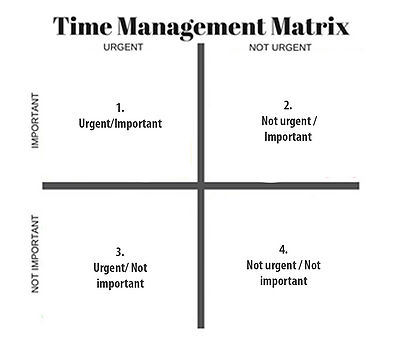The seven characteristic principles
In the light of the modern technology world we live in today it has become more complex, stressful, and demanding for us humans. Especially when one must find a balance between work, family and your own self. For one to achieve higher aspirations and overcome great challenges in once projects and life, Stephan R. Coveys has come up with seven principles. [1]
Stephen R. Coveys approach is an inside- out approach and focus on one’s character ethics which is the foundations of one’s success. The character ethics is about one’s integrity, humility, courage, and modesty. To achieve one’s success and happiness one must look inside with the help from the seven principles. To achieve greatness, you must plant the seeds and work with your own self. [2]
This article presents the seven approaches to help one with becoming more effective in reaching one’s goals. It is all about aligning oneself based on one’s characteristic ethics to achieve one’s goals. The article covers the seven principles and their limitations, connecting the dots and its practical relevance in project management.
Contents |
Context
What are habits?
To understand the seven habits, one must first understand what habits means to having a successful project or work team. Habits are rituals and behaviors we as humans do automatically without thinking about it. Habits are connected to an activity e.g. brushing one’s teeth. [3] To incorporate or change a habit one must have an open mind for it to happen. An equally important thing you need to have in order to change or adapt a habit are the following three things: knowledge, skill, and desire. Knowledge is the question one must ask what to do and why. The skill is where one should ask how to do. Desire is wanting to do. Changing a habit or adapting one can be hard and therefore it is important that you are motivated or have a greater purpose for why.
When incorporating the seven habits from Stephan Coveys you can divide them into three criteria, the Private Victory, Public Victory and Renewal. The Private Victory is all about working on yourself and understanding how you can become a better project manager. Understanding and working on yourself will give you the boost that is necessary to achieve greatness. It is all about going from being dependent to independent. The Public Victory is what Stephen Coveys calls the maturity continuum, which consists of three levels of dependence, independence and interdependent. Dependence is the relationship between a boss and the employer and their attitude towards each other. Going from dependence to independence means you need to understand the first three habits to become the I. The interdependence is where you will be thinking like a team and not about the I to accomplice the goals or scopes set. The interdependence phase will be described in habit four to six.

1. Be proactive

The most important habit!
Take responsibility for your own life. The human being is a unique specie because we have self-awareness. This means that as a human you have the possibility to learn and analyze your own experiences as well as other people’s experiences [1]. This allows us to change or adapt habits. Being proactive you are driven by your values and therefore take responsibility for your life and the choices you make. Being able to be a proactive person means that emotions does not affect the work environment, whereas reactive people are the opposite. In other words, Mahatma Gandhi said:
"They cannot take away our self-respect if we do not give it to them." [5]
Our language is a powerful tool to determine if you are a proactive person or reactive person. The proactive person will take responsibility and take matters into his own hands and will have wayed out the consequences of the choices he has made. [1]
Another way to look at this by the Circle of Concerned/ Circle of Influence is how to spend your time wisely on things, which you can control and not on thing, which you cannot control.[1] Looking at figure 2 The Circle of Concerned is things that are out of your control e.g. people’s opinions, others’ mistakes or economy.
The Circle of Concerned are people that are reactive, who complain a lot, and their mood tends to affect the people from the outs. This leads to them not taking action or responsibility of the things that they are able to control. This is shown in figure 2 where the reactive people have a negative energy.
The Circle of Influence are people are thing you can take into matters and can be controlled e.g. your attitude, your goals, skills to learn. The proactive people take responsibility for their decisions and it determines their way of living and not their conditions. They don’t dwell on things, which they cannot control, but act and improve the things they are able to control. They also know that at times there are things that cannot be controlled, but they are able to control the way they react to the situation. This is shown in figure 2 where the proactive people have a positive energy. [1]
Do not dwell on things you cannot control but take responsibility to the things you can. This gives you a stronger way of living and more power. Being proactive in project and portfolio management will give a stronger output and a stronger team. You want to act rather than being acted upon! To be proactive is something that can be used in project and portfolio management.[1]
2. Begin with the end in mind

Everything in our minds are created twice. First one creates an idea or a habit in their head and then they seek it out [1]. Like in building project the Architect has an idea in his mind of architectural looks of the building and then begins to make blueprints and construction plans. To reach the goals in life it is important to create a map to determine the lifegoals and the destination to reach them. Everyone has at least once in their life been asked where they see themselves in five, ten or fifteen years. If you cannot answer, you are wondering around without any purpose in life. This can also be related to a project. If a project manager does not have a clear purpose of the project, it is likely that the project will not be a success. If the project has a clear purpose, the chance for it being a success it big. Find your destination and work towards it. Do not ask what life can offer you, but what you can offer life. [2] Leadership vs Management:
"Management is doing things right; leadership is doing the right things." By Peter Drucker and Warren Bennis [1]
Leaders are the ones who have a vison on where the companies are heading, there mission, visions and the company’s goals, whereas managers are hired to make sure that the companies’ goals and values are aligned. [6]It is crucial that the project manager can lead a team to achieve a successful project. In the PMBOK it states that the project manager leads his team to achieve the project goals and to make sure they satisfy the stakeholders expectations. [7]
3. First things first

Put first thing first is the personal fruit and writing the program, taking the necessary steps that are needed to realize and make them happen. With the knowledge from habit one and habit two you start to analyze the daily habits and ask yourself what is the most important thing in your life? It is important to focus on the things that really matter instead of on trivialities. This is where you should question the path, you’re on and analyze your habits, hobbies, addictions and scripts in your life. [1] By questioning the path one is taking, can also be transferred into project management. By asking how you can manage your time effectively in a stressful daily routine. The best way is to organize it is by making a time management matrix. You divide the tasks into what is urgent, not urgent, important, and not important.
The first quadrant is everything that is urgent and important. They are therefore activities that are crises or problems that need to be solved here and now. It is things that need immediate attention and are important for the project to keep moving forward. E.g. deadlines that need to be met or pressing problems that need here now decisions. In big projects, 90 precent of the time you will be dealing with urgent and important things. If you are only stuck in this quadrant it will lead to stress and burnouts.
The second quadrant are things that are important but not urgent and therefore things that does not need to be solved right away. It can be things like making plans or calls you need to make that are important but not urgent. This quadrant is important because it is here you will spend time updating and evaluation documents and schedules. It is also here things often get less prioritized but if time spend here the pay off in the long term will be high. Therefore, this quadrant should have one of the highest prioritizations in the time management matrix.
The third quadrant are things that are not important but urgent to reach the goals. It can be answering emails or solving problems that are urgent. E.g. if there is a miscommunication or misunderstanding of what to build or a solution needs to be found. In this quadrant it is important to delegate the work, so you don’t have two people working on solving the same problem.
The fourth quadrant are things that are not important or urgent and spending too much time on it will lead to waste of time. It can be wasting time on things that are wrong or things that are outside of once decision or control.
This matrix can help you delegate your time optimally, so that you don’t waste time on things that are not important. This will give balance to the project but also one’s life and make plans on where the project is going and where you want or should be. Focus on what is important to you or the project and make it a priority.
4. Think win-win
In Habit 4 there are six different types of human interaction.
Win – lose (self-centered) Generally, people who have a Win – Lose approach are often people who use their position, powers and credentials and who always think for their own benefit. This means that one part will get a good deal and the other will get screwed. A typical example could be when a person is suing someone in court and wins. [1]
Lose – win (nice guy) In this situation a person does not have any standards, demands, expectations or visions and is easy to please. This person usually has a low self-steam and can easily be dominated by other people. They will try to please everyone else and let people walk over them. When dealing with them they will give in or give up quickly. Self-centered people feed of the nice guys because they use their weaknesses. [1]
Lose – lose (stubborn) This situation is where you will have two people of the same kind. They are stubborn, egoistic and determined and therefore none of them will win or gain anything. This situation is not good for anybody. [1]
Win (Selfish) As a win type you seek to win but not necessarily want other people to lose. It is important to come first and to get what you aim for. They will strive after getting to the top and achieving their goals no matter what. Therefore, this relationship is where you get what you want and where you do not provide value to anyone else. [1]
No deal (neutral) If you can find a deal that benefits all, then you have no deal, and no one will get anything. This usually happens when both parties do not share the same values or goals and see the project going two different ways. When having a no deal approach you feel liberated due to not needing to manipulate or push one’s agenda to get what you want. [1]
Win – Win (best type) As humans we want to look for things that benefit us. By having a win – win relationship the two parties agree on a mutual solution that is beneficial for all. This way you can share knowledge, gain knowledge and profit together. [1]
Depending on what you want to achieve the different types of human interaction has pros and cons. From a project management view a Win – Win situation is the best. This is where both parties will gain benefits and use each other’s strength to achieve the goals and work. The collaboration will give both parties value. This also shows teamwork and that you want to both gain and give knowledge.
5. Seek first to understand, then to be understood
A project manager spends around 80 percent of his time communicating about the project. Having a a good communication is therefore essential, but can be difficult. That is why understanding each other is important. To understand this habit, I will start by painting a scenario. Two people are talking and one of them feels like they could get through an issue they are having. The person therefore goes to a colleague for advice and tells the colleague that he does not understand why the other person does not understand him and feels like they are not listening to him. The colleague tells him that you do not understand them because they do not listen to you and to understand someone you must listen to them. [1]
If you want to understand someone you must listen to them and try to understand them. Everyone looks at the world differently and think different. E.g. when a project manager is communicating out what he wants, he paints a picture in order to be sure, that the other person understands. But it is also important that the person receiving the information is listening and tries to understand him and does not get frustrated.
There are different types of persons and ways of listening to others. One of them is being an empathic listener, which is the highest level of listening. As an empathic listener means that you are actively listening to the other person and that you try to understand the other persons perspective first, understand how they are feeling and why they are feeling this. [1] You keep your focus on them, have a positive mind set and allow them to finish before you talk. This will set you up for success when doing projects.
6. Synergize
When brainstorming in a group consisting of at least two people will give a more diverse perspective and a lot of different ideas. Rather than brainstorming alone it becomes one perspective and only one way of thinking. The best projects are projects, which involve people with different backgrounds and specialties. Combining the different strengths, ideas and opinions means that you explore the projects outside of it limits and find the best solutions.[1] Another way of thinking of this habit is your body. All your organs have different functions, but they work together to make sure that you are breathing, able to walk, talk, think etc.
7. Sharpen the saw: Growth
The last habit is about preserving yourself and this habit is about making all the other six habits possible. You need to think of yourself as an instrument, which you have to sharpen regularly. This means investing in yourself. [1] This can be done by renewing four dimensions:
Physical: Find out what is important in your life but not urgent. This can be looking out for yourself and your health by eating right, exercising regularly, being able to relax and getting the necessary rest. If you take care of your health now you will minimize physicals problems later in life. this is what is meant with sharpening the saw. [1] Take care of yourself because when your physical health is good you can achieve more things.
Spiritual: The spiritual dimension is about looking inside of yourself and finding a balance in your life. Sometimes it can be good to ask yourself who you are and where you are going. The spiritual dimension is about finding inner peace, and this can be done through e.g. meditation, praying, art or listening to music.
Mental: Often people do not maintain their curiosity to continue to learn and explore languages or expand their education. If you keep being curious and keep feeling the urge to explore things, you can broaden your knowledge and views. New technology will also keep you on track. [1]
Social/Emotional: The Social dimension goes hand in hand with habit four, five and six. It is all about our lives and how they are tied to our emotions. Having human contact and interaction with people we care about is important. It is where you can gather strength, emotional support, and interact with loved ones. Therefore, it is important for us to spend time with and to prioritize family, friends and loved ones to have balance in life.
Limitations
There are limitations to the 7 Habits of Highly Effective People by Stephen Covey. If a person from the beginning is not open to change their habits or willing to try to change then these principles cannot be used. You must be completely open and completely honest to yourself because it is only you who can change things. It is just like people who smoke. No one can make them stop or change their habit but themselves. They need to be willing to change in order to be able to stop smoking. Sometimes when one is willing to change a bad habit, the person will need to replace it with something else. As Stephan Covey says:
“The personal power that comes from principle-centered living is the power of a self-aware, knowledgeable, proactive individual, unrestricted by the attitudes, behaviors, and actions of others or by many of the circumstances and environmental influences that limit other people” [1]
Conclution
Even though this book was written 30 years ago it is still relevant today. No matter your age, the seven principles can be applied to everyone who is ready and willing. The seven principles can be used to become better and achieve greatness. The first three habit are about working on yourself and becoming a better self. Habits four to six are about being the best you can in a teamwork. It is also here that you can find out the type of person you are in a team. Having a good relationship in a teamwork means that the project will have better successes. The last habit is all about finding balance in your life, so you do not burn out. The habits do not only give the individual a tool to make you better but also a project manager can use a tool like the time management matrix to make sure that the time spent on the project is well used.
Annotated Bibliography
- Covey, Stephen R.;The 7 Habits of Highly Effective People, Simon & Shuster, 2nd ed. 2004
This book was written by the author Stephen Covey’s with the focus on seven habits to achieve greatness. His book is timeless and relevant for both one’s work life and one’s personal life. This book provides the help you need to be more effective in your life. Stephen Covey describe examples from his own and friends’ life to make it more reliable for the reader. Before reading this book, one must start with an open mind and willingness to change one’s habits.
- A Guide to the PROJECT MANAGEMENT BODY OF KNOWLEDGE (PMBOK® GUIDE) Sixth Edition
The PMBOK standard and guidance provides guidance and tools to become a project manager and helps one understand the different phases and therefore helps you become more structured in your daily life. This book is divided into different chapters describing the seven habits to structurally help you throughto become a good project manager.
References
- ↑ 1.00 1.01 1.02 1.03 1.04 1.05 1.06 1.07 1.08 1.09 1.10 1.11 1.12 1.13 1.14 1.15 1.16 1.17 1.18 1.19 1.20 1.21 1.22 1.23 1.24 Covey, Stephen R.;The 7 Habits of Highly Effective People, Simon & Shuster, 2nd ed. 2004,
- ↑ 2.0 2.1 https://www.youtube.com/watch?v=WFc08j9eorQ
- ↑ https://www.thepositivepsychologypeople.com/habits-to-happiness/
- ↑ Covey Sean; The 7 Habits of Highly Effective People, The Ultimate Teenage Success Guide, Simon & Schuster, 1nd ed. 2014, ISBN13:9781476764665
- ↑ https://www.goodreads.com/quotes/92836-they-cannot-take-away-our-self-respect-if-we-do
- ↑ https://blog.smarp.com/leadership-vs-management
- ↑ A Guide to the PROJECT MANAGEMENT BODY OF KNOWLEDGE (PMBOK® GUIDE) Sixth Edition